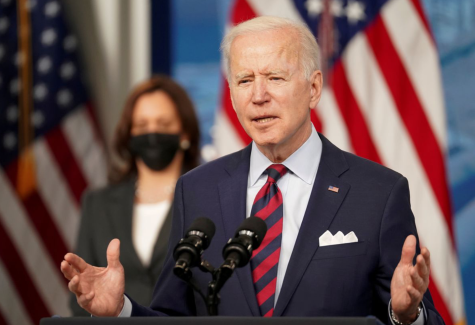Cap or No Cap: Biden’s Vacillating Refugee Stance
April 28, 2021
During the presidency of Donald Trump, inflammatory racial rhetoric and sensational policy threats held the nation’s attention on immigrant and refugee rights. January’s inauguration — coupled with a long-overdue social media ban for the former president — brought an end to Trump’s harmful commentary on the matter. Many previously outraged voters mistakenly equated a cessation of xenophobic presidential discourse with a resolution to the issues faced by immigrants and refugees themselves. Those who felt free to relax under President Joe Biden’s administration were secure in the assumption that his progressive campaign promises would come to fruition. However, while Biden has refrained from open condemnation of refugees and eased some discriminatory restrictions, he has fallen far short of his promises to the global refugee population and the American communities who await their arrival.
By February, Biden had reduced his aspirational refugee cap from 125,000 to a more conservative 62,500 without raising too many eyebrows. On April 16, he decimated even that number in favor of maintaining the Trump-era cap at 15,000, leaving thousands of preapproved refugees stranded far from their final destination. Political backlash from fellow Democrats was swift, obligating the Biden camp to rescind its announcement and promise a higher number by May 15, but public discourse remains largely unchanged. If U.S. onlookers wish to see real change on refugee and immigration rights, constant vigilance and activism from voters is imperative to align all administrations with refugee interests in both word and deed.
Americans are all too familiar with the pattern of transition between campaign promises and results. Many candidates, naïve to the realities of legislation, overpromise and underdeliver. However, Biden was intimately familiar with the realities of working around Beltway gridlock, having served as Vice President during both terms of Barack Obama’s incredibly polarized presidency. In fact, his campaign assurance of admitting 125,000 refugees during his first year, while ambitious, was not far from previous U.S. averages, which were around 95,000 annually before 2018.
Press Secretary Jen Psaki’s characterization of the White House’s rationale for adjusting that number has been conflicted. She denied, then confirmed, that Biden weighed increasing immigration numbers at the Southern border, now deemed a “crisis,” in making his refugee cap decision. While addressing the immigration influx is a noble goal, there is no reason it would stand in the way of accepting refugees from other nations. Processing for refugees, who are vetted and approved before traveling to the U.S., has always taken place separately from immigration procedures. Around 35,000 such refugees — more than twice Biden’s allotted number —have already completed the approval process and await nothing but permission and a plane ticket to begin their new lives.
“The U.S. has always been able to walk and chew gum,” Krish O’Mara Vignarajah, the chief executive of Lutheran Immigration and Refugee Service, summarized for the New York Times. “[Immigration and refugee processing] are two completely distinct pathways and programs.”
There is no real explanation for the novel failure to coordinate both under President Biden — unless genuine effort has not been paid to the endeavor.
Other circumstances may legitimately be complicating the ideal of raising the refugee cap. The new administration certainly has a full plate, given the global pandemic, ensuing economic crisis and ongoing military engagements. Each of these factors also serve to swell the global refugee population, which surpassed 80 million in mid-2020 and will only continue to rise. Biden officials have been quick to blame the Trump administration for gutting the previously established system by cutting funding, closing out international positions and limiting officials’ travel. These circumstances may justify the adjustment of Biden’s aspirational cap to 62,500, with the promise of revamping these programs and arriving at least at the pre-2018 average by the administration’s second year. Instead, Biden decided not to raise the Trump-era cap at all and provided no timeline for doing so. His rhetoric may differ from his predecessor’s racist precedent, but this only serves to protect Biden from the public’s censure, rather than protecting the refugees themselves from Biden’s identical xenophobic policy decisions.
Legislative compromise is, to some extent, inevitable, but that should not exempt Biden from the obligation to retain his focus on refugee rights. Compromising away the lifeline of thousands of refugee families, especially without providing sufficient explanation or a specific plan for addressing their needs in the future, falls far too close to the Trump precedent for comfort. At the end of the day, the only policy choices that are truly unacceptable are the ones we the people refuse to accept. Eagle-eyed public oversight of the presidency was a new practice for many in the days of Trump, but it is a habit that the American people must maintain to protect the interests of those most vulnerable from even our progressive presidents.











